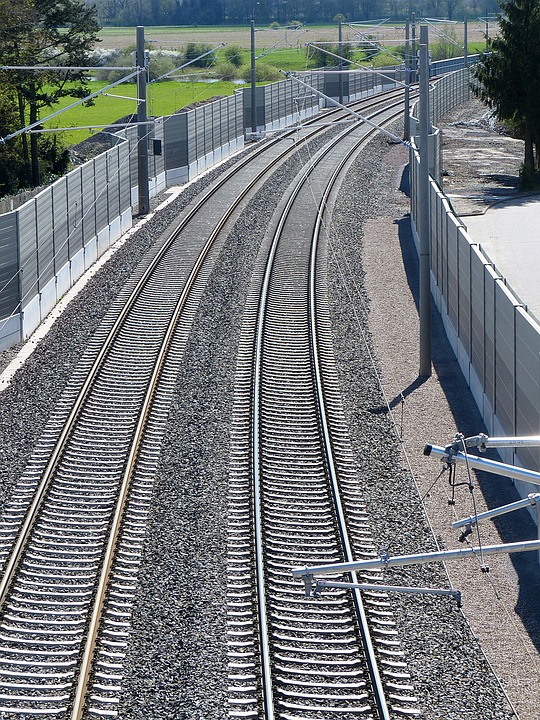2.3.1 to 2.3.4
Course subject(s)
2. People and the Railway Network
2.3.1 Urban Barrier or Opportunity
Railways, particularly stations, can greatly add to a city, both as a hub for new business and as an architectural landmark. We will look at different ways how the railway network influences its surroundings, dealing with both environmental and urban limits and challenges. Before getting into detail on nuisance, we will start this section with analysing how railway tracks can either form a physical and/or social barrier, and when this can be an opportunity rather than a problem.
Southbank London, United Kingdom
Situation: The Southbank Centre of the river Thames in London has been in developing since the early 1950s when the festival of Britain was organised. Over the years it became a cultural arts district next to the railway line connecting Embankment Station across the Thames. Where one side of the track has extremely flourished, the other side became a setting where no one wanted to come. The station and its lifted rail track have dominated the area, cutting the Southbank into two.
 In the centre image above the yellow lines represent the ideal way to walk towards Waterloo Station, London’s largest railway station which is used by over close to a hundred million each year. These travellers are mostly commuting and tend to use the fastest way. The blue/green lines represent how people actually walk, which are different routes, avoiding the undeveloped site of the Southbank. Lastly the purple dots are where people feel unsafe, where the blue, green and yellow dots are where they would like to be. The railway bridge forms an extreme barrier between both.
In the centre image above the yellow lines represent the ideal way to walk towards Waterloo Station, London’s largest railway station which is used by over close to a hundred million each year. These travellers are mostly commuting and tend to use the fastest way. The blue/green lines represent how people actually walk, which are different routes, avoiding the undeveloped site of the Southbank. Lastly the purple dots are where people feel unsafe, where the blue, green and yellow dots are where they would like to be. The railway bridge forms an extreme barrier between both.
Below the north side of the railway track on the left with the liner building (by Allies and Morrison) shadowing the railway track and on the right the dilapidated south side used for storage, parking and loading (photo: TU Delft).

Opportunity: Where Allies and Morrison successfully developed the northern side of the railway in 2007, multiple competitions had been launched over the years to integrate both sides. In 1999 Rick Mather Architects was selected to make a masterplan for the Southbank. To start of the masterplan a few important principles were established; accessibility, legibility and the public realm. They aimed for a greater mix os users also for longer periods of the day.
Where the masterplan was never fully realised, multiple architecture firms and landscape designers got involved in this challenging project. Where Allies and Morrison made follow-up plans for further development of the Southbank Center, new competitions were launched to integrate the railway track. West 8 started working on maximising the public space in the Jubilee Gardens on the south side (close to the London Eye).
Between 2007 and 2013, three public squares have been created on the side of Royal Festival Hall, Hayward Gallery and Queen Elizabeth Hall, the ‘liner’ building was placed on the north side of the Railway Bridge, making a new pedestrian route onto the Hungerford Bridges and shielding the public space and Royal Festival Hall from the high lifted railway and the Jubilee Gardens were developed into a high quality park. Enough potential to make the connection, but the car park next to the railway bridge stayed empty.
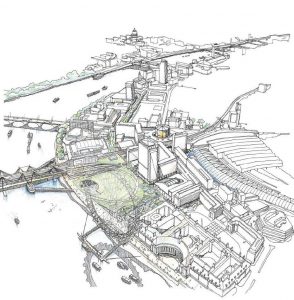
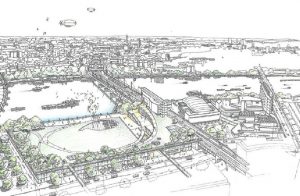
Above two visualisations of Rick Mather’s proposed master plan integrating the railway track fully within a continuous design between Southbank Center and London Eye (source: rickmather.com).
High Line New York City, The United States of America
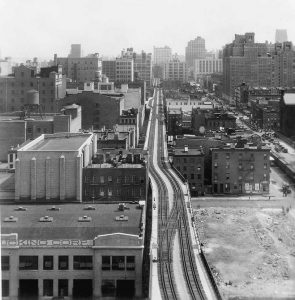 Situation: the High Line in New York was originally built for the transportation of meat and poultry, and was finished in 1934. The line is 2,3 kilometers long and runs parallel to 10th Avenue. Because the popularity of automobile transportation increased, the last train to use the line was in 1980.
Situation: the High Line in New York was originally built for the transportation of meat and poultry, and was finished in 1934. The line is 2,3 kilometers long and runs parallel to 10th Avenue. Because the popularity of automobile transportation increased, the last train to use the line was in 1980.
The High Line is, as the name implies, higher than ground level. In this way, it has created a form of barrier in the city.
Image: the old situation of the High Line in New York City (source: Friends of the High Line)
Opportunity: Around 2003 plans to give the unused high line a new purpose were developed. The city council of New York decided to turn the line into a park. This park is designed by the Dutch architect Piet Oudolf. In 2009, the first part of the park opened for visitors and has been a success since then. Instead of being a barrier, the High Line now connects people and urban space.
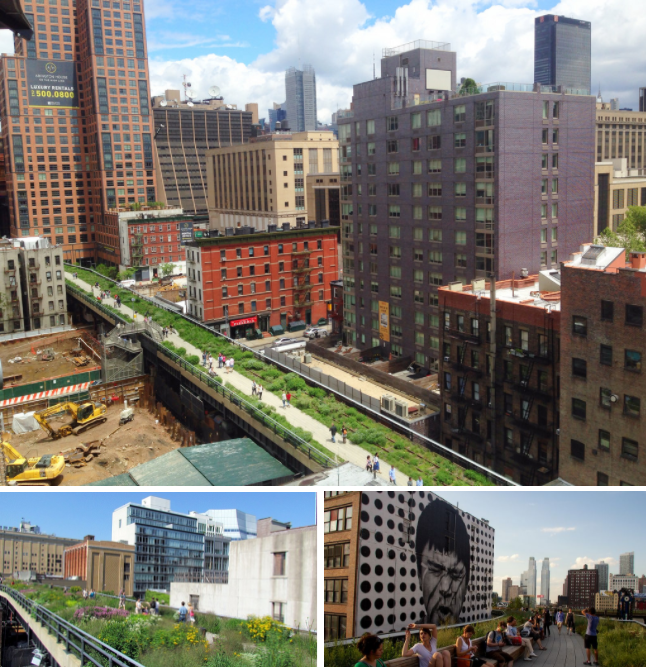 Image: current situation of the High Line in New York City (source top image: David Shankbone, bottom left: David Berowitz, bottom right: Mike Peel)
Image: current situation of the High Line in New York City (source top image: David Shankbone, bottom left: David Berowitz, bottom right: Mike Peel)
Railway Master Plan Delft, The Netherlands
 Situation: The train track in Delft dates from 1847 and was built on the west side of the city. Later, the city grew and the track no longer bordered the city, but split it in two. The solution for this was to lift the train track on its own railway arch, and underneath this viaduct, parking placed were created. However, this made it an unpleasant area, which was experienced as a barrier in the city.
Situation: The train track in Delft dates from 1847 and was built on the west side of the city. Later, the city grew and the track no longer bordered the city, but split it in two. The solution for this was to lift the train track on its own railway arch, and underneath this viaduct, parking placed were created. However, this made it an unpleasant area, which was experienced as a barrier in the city.
Image: old situation Rail Zone Delft, The Netherlands (source: OnafhankelijkDelft.nl)
Opportunity: The urge to solve the unpleasant situation grew and eventually a 2,3 kilometer-long tunnel for the train was built instead. Putting the train track underground meant a lot of space on ground level was opened up. This made it possible to redesign the Rail Zone in Delft. The design also included plans to reconstruct the canal that was once parallel to the train track, make room for a park, build houses and other facilities, like a school. In addition, the old train station has been replaced by a new one.
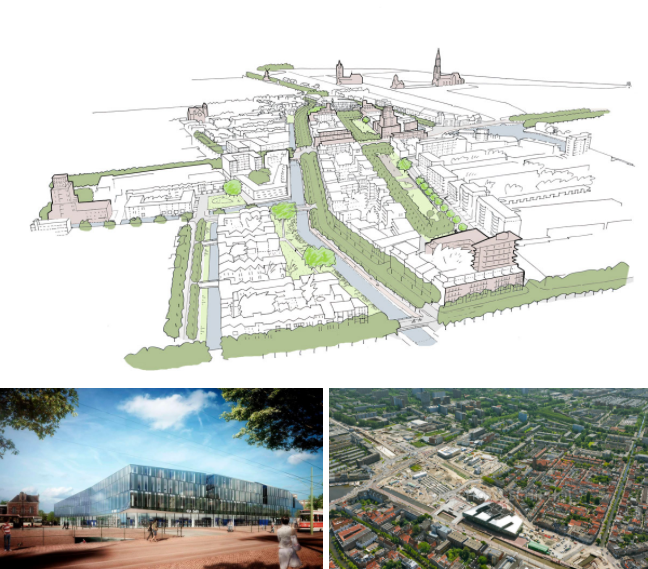
Images: current and planned situation Rail Zone Delft, The Netherlands (source top image: Palmbout, bottom left: Mecanoo, bottom right: Marco van Middelkoop – Aerophoto-Schiphol)
Did you know?
In early years stations were often placed on elevated platforms. This way a train approaching the station ‘automatically’ would decrease in speed, where trains leaving the station would gain it. Both usually cost a lot of power, which was saved by a smart way of designing.
2.3.2 Noise and Vibration
As an infrastructural network, railways have a great influence on their surroundings. As an continuous element through connecting cities and countries and actual interfaces with our road/pedestrian network like stations and crossings. In some cases this includes nuisance for surrounding areas.
Noise and Vibration
The effect of a railway extends beyond the convenience of travel or the offerings of its related stations. In this section, we will examine the impact on the immediate surrounding of a railway line.
A train generates noise and vibration hindrance for both people living close to a railway and people in the train. But where does this hindrance come from and how can it be reduced?
The track consists of different elements made out of different materials, for example: the rail pad, sleeper pad and ballast. Having different elements results in different levels of stiffness on the track. The displacement at the point where a sleeper is located will be less than the point where it is not, because the rigidity is higher. An optimal situation would be to have a constant stiffness throughout the whole track. Since this is not possible, however, it is important to limit the stiffness variation as much as possible.

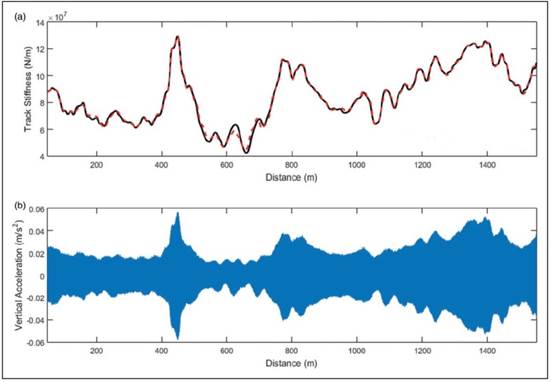
When a train moves and interacts with this uneven track, it creates an energy flux, or input. Part of this energy flux will be absorbed by the track which causes deterioration of the components. More maintenance activities are needed to repair the damage of the track. The other part will be transmitted through the soil and the air in the form of vibration radiation and environmental noise.
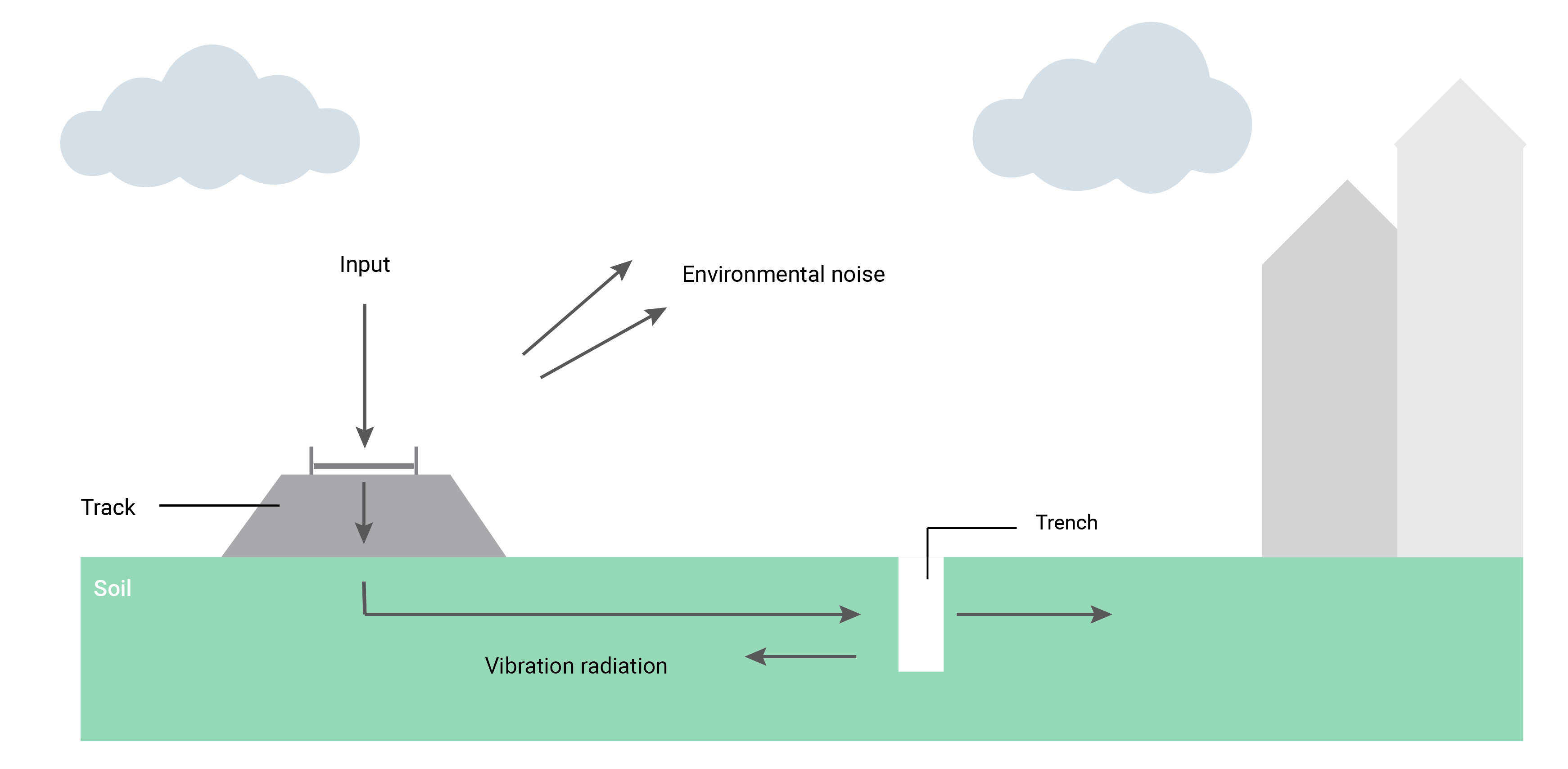
Unfortunately it is really difficult to reduce this noise and vibration due to the dynamic force of the train on the track, but there are three ways to limit the hindrance:
- Noise and vibration reduction at the source (e.g. elastic pads under the sleeper, ballast mat)
- Noise and vibration reduction at the receiver (e.g. pads in the support of houses)
- Noise and vibration reduction between the source and the receiver (e.g. barriers such as walls, trenches)
Additional sources of noise
Besides this standard contact noise, also other factors can introduce extra noise. For example a wheel flat of the train will create an impact on the rail at each rotation of the wheel. This impact creates an extra vibration, which can clearly be heard while standing next to the track during the passing of a train with wheel flats. In the video on the left you can hear wheel flats especially on the front end of the train.
Another noise that is commonly heard close to stations and in bends is a high-pitched squeaking noise. This noise is being generated by the contact of the wheel flange and the rail. This is common in switches since in this case the rail can have no cant, but also in bends this will happen when different trains tend to pass at different speeds. As seen last week also tram lines have this problem since they can not have any cant in the curves. A good example from flange squeal can be heard in the video on the right.
These forms of noise production, due to having a specific cause, can more easily be targeted. For the unroundness of wheels frequent inspection of the wheels can reduce the problems. Also microphones next to the track can help in identifying problematic wheels.
For flange squeal, a reduction of switches and standardization of speeds in the curves can reduce the problem. When this is not possible lubrication can be added to reduce the noise.
2.3.3 Bridges and Tunnels
Constructing a railway network can be influenced by cities or environmental obstacles: mountains, rivers or any change of soil can be a challenge either during the design or at a later stage due to track settlement. In week 4 and 5 we will look at both disruption that might come from this as well as maintaining critical parts of the network, but in this section the common design solutions are discussed, by means of tunnels and bridges, to adapt to these limitations. This can be best explored by looking at some international examples.
The Gotthard is the world’s longest and deepest traffic tunnel. Shifting freight volumes from trucks to trains also made the transportation safer and reduced environmental damage. It also provides a faster connection for travellers, cutting the journey time from Basel to Milan by an hour.
Chenab Bridge is a railway steel and concrete arch bridge between Bakkal and Kauri in India. When finished, the bridge will span the Chenab River at a height of 359 m (1,178 ft) above the river, making it the world’s highest rail bridge.
The Chongqing Metro line 2 Monorail in China passes right through an apartment building, creating an unusual sight. With lost of the area being slopes (the city is called ‘mountain city’), this solution was found to create a light rail system.

From left to right: Gotthard Tunnel with smaller tunnels in both directions (by Hannes Ortlieb), Chenab Bridge exceeding the height of the Eiffel Tower and Chongqing Metro Monorail passing the Jailing river through a building.
Sometimes issues coming from large projects like these, are not directly related to the construction, planning or usage of the railway track. After the new underground railway station in Delft, The Netherlands opened to the public in 2015, an unexpected issue occurred that vey same day. When trains passed by faster than 80 km/h the revolving doors within the station entrance hall would turn at a very fast speed, creating inconvenient, sometimes dangerous, but for bystanders rather funny situations.
No-one thought before opening to have trains pass by at regulated speed. It was supposed to be an event which reached all news channels and it did, but probably not in the way the stakeholders would have planned it.
255 meter moved into place
One of the largest projects involving a bridge within The Netherlands is the expansion of the A1 high way connecting Amsterdam to the east. To retain the existing railway connections, a bridge of 255 meter had to be designed which was constructed next to the highway and moved to it location as one element. With a total weight of 84000 kN and a height of 59 meter a complex venture.
Since soil calculations showed that the highway was not able to hold such a load, it had to be reinforced and due to the height and length of the bridge it was a necessity to make limit elevation to a minimal (where highways usually have several percent elevation for drainage).
Below an animation (in Dutch) of the built and movement of the bridge (frist video) and a timelapse of the actual event (second video).
The transport was done by special vehicles, having 488 wheels on each side and moving only 1 meter per second. The allowed vertical deformation was 50mm which together with all other factors took over a year of planning. A specific day was chosen to limit the inconvenience by a minimal. There was no big concert in or around Amsterdam, no sporting event and road traffic could be redirected via other routes.
Everything still could have been called off on the day itself by the one factor you cannot control: wind. If wind speed would have exceeded the maximum 49 km/h the project would have been cancelled after detailed planning with hundreds involved.
Above drone imagery of the bridge after it was moved next to the existing railway line (third) and the first train passing the new bridge (fourth).
This obviously is an extreme example, but it shows how many factors can be involved if civil structures are needed within the railway network.
2.3.4 Transition Zones
In the previous section, we talked about obstacles in the environment and how they can be tackled with bridges and tunnels. This section will be about the transition zone, the zone between the free track and the fixed structure (e.g bridge). Due to different problems that occur in this zone, transition zones often require additional maintenance. These problems can be solved, but these solutions are costly.
The video below depicts an athlete jumping from a springboard onto a raised platform: how do you think the gymnast’s movement can relate to the transition zone?
What are the similarities between the movements of this gymnast and a train?
Dynamic Behaviour
Railway tracks designs are based on static behaviour, which can be the reason that they encounter dynamic problems in the transition zone (i.e the first few meters of track connected to the fixed structure).
When the normal track is built on top of softer subsoil (which is often the case around rivers, for example), the weight of the track itself, combined with the load of passing trains, will cause subsidence in this subsoil. The bridge, however, of which the foundation reaches the deeper stable layers of soil, is not subject to this subsidence. Due to this, over time a difference in height between the bridge and the normal track will be introduced. Since the rail is continuously welded, in the transition zone, this height difference is overcome gradually, but this will mean some sleepers at this transition zone are not well supported by the ballast.
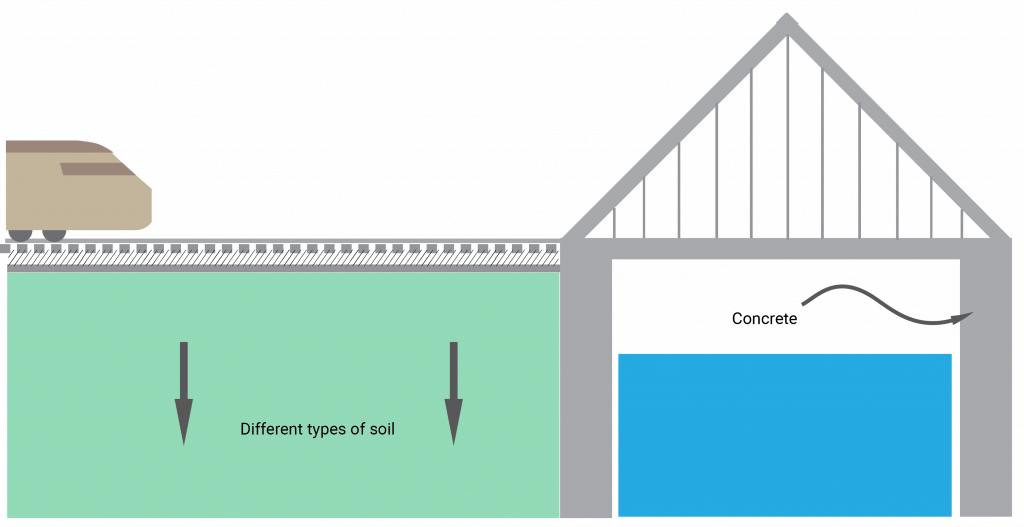
The introduced height difference has to be overcome by any train passing over this bridge. This means a vertical acceleration of the train is required at the transition zone. The force of this vertical acceleration mean an additional load on the transition zone, which is repeated at every passage of a train. This increased load at the transition zone, results in extra subsidence in this zone, thus further increasing the problem.
Due to the newly-created difference in height at the transition zone, the sleepers are no longer properly supported by ballast. Thus, in the end, not only are the forces in the transition zone higher due to the acceleration, but there is also less support. This means the rail has to deal with far higher internal stresses than seen in other locations on the track. Damages to the rail itself are thus far more likely to occur at this location, and at worst case result in a derailment.

Aside from the technical issues, passenger comfort is also negatively influenced at the transition zone. The subsidence in the transition zone has a similar effect on a train as a springboard has on a gymnast. The train will first jump down into the ‘hole’ in the track, after which it has to be launched upwards to reach the same level as the bridge. This can be clearly noticed by passengers on the train. When nothing is done about the problem, this effect will just keep worsening over time, and can even cause passengers to fall over while standing in the train.
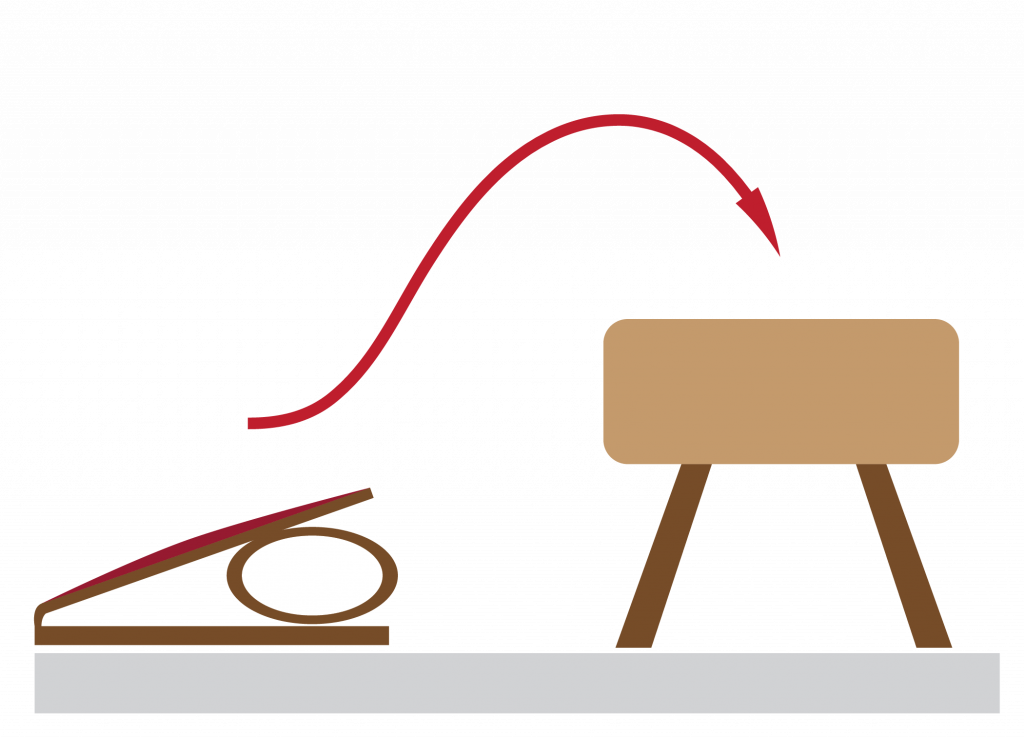
Many solutions are currently used to reduce the effects seen in a transition zone, such as the use of wider sleepers (to reduce internal stresses in the soil) and adding extra rails (to increase the stiffness and reduce the stresses in the rail). Some more advanced solutions have been proposed as well, such as placing a balloon underneath the transition zone, which can be automatically inflated to counteract the height difference. Another solution can be a construction in the shape of a slope to create a smooth transition. Although all these solutions can help in reducing the problem, none of those will prevent all the dynamic problems that will occur. The only real solution would be to make the foundation of the track the same over the whole length of the track, thus rather than using ballast track, using slab track with deep foundations. This however is very expensive to do and by itself will introduce completely different problems.
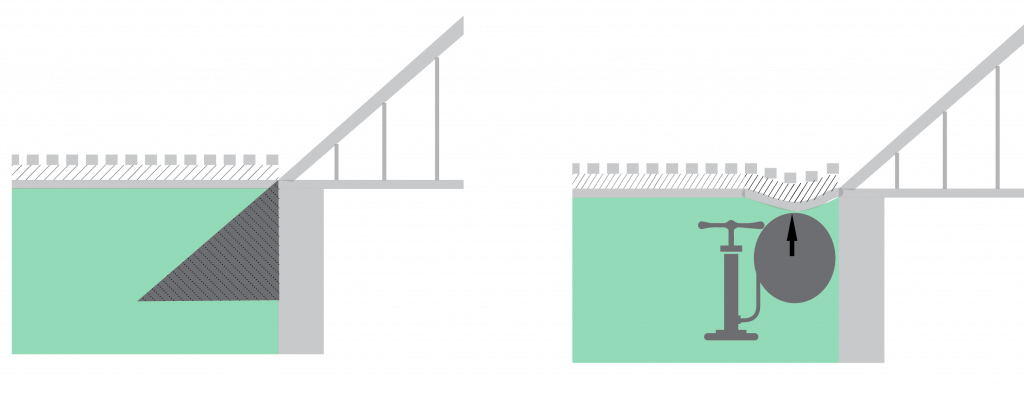

Railway Engineering: An Integral Approach by TU Delft OpenCourseWare is licensed under a Creative Commons Attribution-NonCommercial-ShareAlike 4.0 International License.
Based on a work at https://ocw.tudelft.nl/courses/railway-engineering-integral-approach/.





